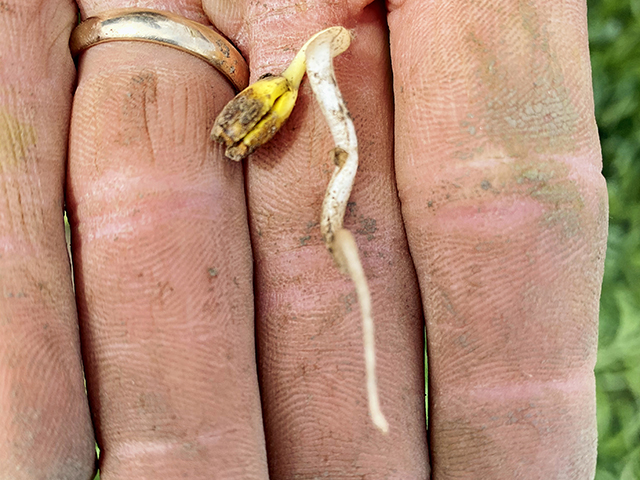Winter Soybean Planting Test
Seed Cold Tolerance Tested
Soybeans planted in December on a Wisconsin farm largely failed to emerge this spring, but the experiment to test hardiness of seed did yield valuable information.
Ryan Nell, who farms 2,200 acres with family near Beaver Dam, seeded 3 acres on Dec. 10 just to see how much stress seed could handle when it comes to early planting. Read "Winter Soybeans Test Hardiness," the initial story, at www.dtnpf.com/agriculture/web/ag/news/article/2021/03/01/research-winter-soybeans-test.
Nell had high hopes the extremely early-planted soybeans, or least some of them, would germinate and grow. Some germination occurred, but almost all did not emerge.
"It's not a great ending, let's put it that way," Nell admits. "We dug some seed up in March, and they were germinating and trying to grow. But, probably 99.9% didn't make it. I'll be the first one to admit defeat."
LESSONS LEARNED
Nell is quick to point out just because his first winter planting didn't work out, that doesn't mean he won't try again if conditions allow. With every setback, he says, lessons are learned.
Nell is an advocate of planting soybeans early to boost yields and profit potential. In addition to the December experiment, he planted 5 acres on March 22, 200 acres from April 3 to 6 and the remainder of his soybean acres from April 21 to 26. May and sometimes even June, soybean planting is common in his area.
P[L1] D[0x0] M[300x250] OOP[F] ADUNIT[] T[]
A Memorial Day weekend frost injured Nell's early-April-planted soybeans, which were about 5 inches tall, forcing him to replant 75 acres. However, the rest of the soybeans -- except for the December plantings -- he says look very good. Per-acre yield potential in the 80s is possible if conditions allow, he adds. The farm average since 2015 is 65 bushels per acre.
The December experiment showed there is a limit to how long treated seed can be in the ground and the amount of stress seeds can withstand, Nell explains. Pushing planting much earlier than late March, even in limited amounts in colder climates, may not work.
"This doesn't deter me (from planting early). We are still learning," he says.
CAUSE AND EFFECT
After talking with family and his agronomist, Nell determined there were several reasons why the December beans didn't grow.
-- Winter was too warm. He expected December-planted seeds to germinate in April, but they began the month before, and conditions following germination weren't favorable for growth.
-- Seed treatment didn't last until spring. Seedling damage from insects, including wireworm and seedcorn maggot, was found.
-- Seed was planted 2.25, 2.5 and 3 inches deep to protect it during the winter, but the ground in the spring was too hard for seedlings to push through at those planting depths.
-- A cereal rye cover crop grew well this spring. It shaded the ground, which didn't warm up as fast and hampered crop growth.
EARLY PLANTING
Soybeans planted in mid-April tend to yield 5 to 10 bushels per acre better than mid- to late-May plantings, according to research conducted by Shawn Conley, University of Wisconsin soybean and wheat specialist. Planting soybeans early is good, but he says there's a limit.
"Generally, I encourage growers don't plant any earlier than their respective crop insurance date to lessen the chance of frost damage," Conley explains. "Planting too early can be trouble. Deep planting, more than 1.25 inches, can also be a challenge."
**
-- Follow Matthew Wilde on Twitter @progressivwilde
[PF_0821]
(c) Copyright 2021 DTN, LLC. All rights reserved.




